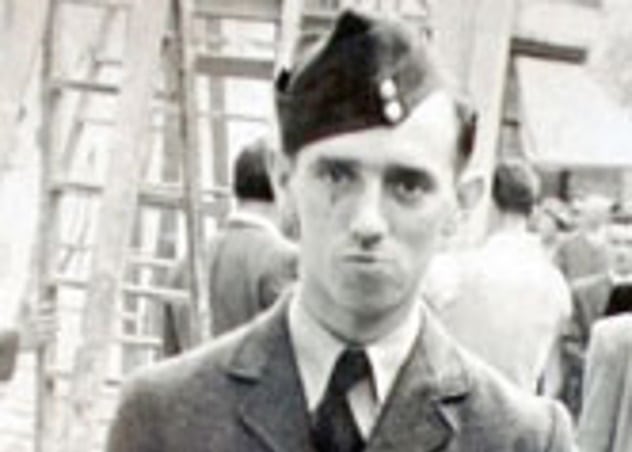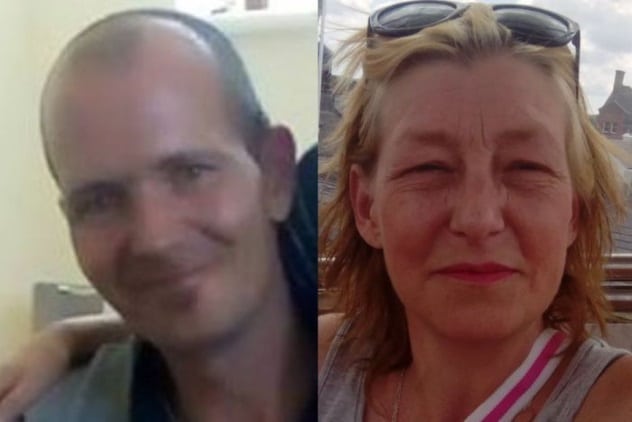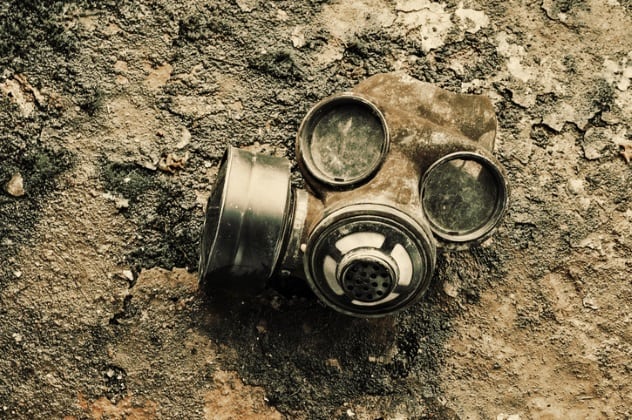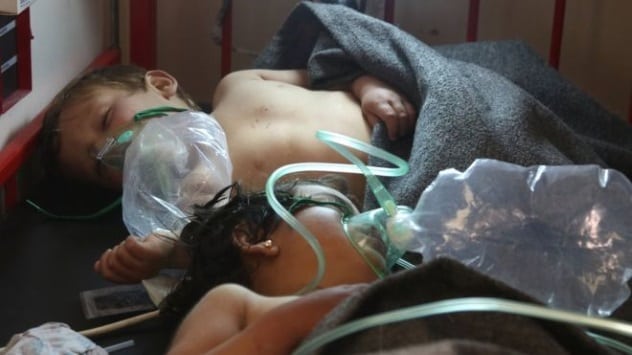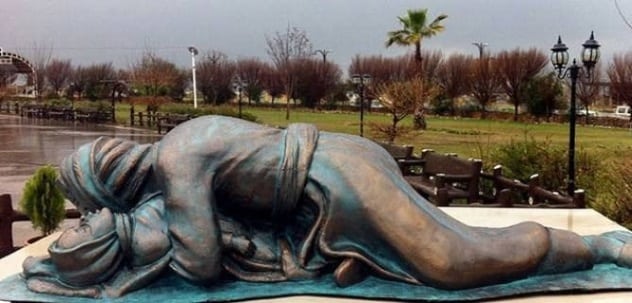Known for their torturous effects, these deadly substances spark a mixture of fear, revulsion, and a little bit of Cold War excitement. Here are ten grisly incidents which illustrate their lethal powers.
10 Skull Valley Sheep KillUnited States
The Dugway Proving Ground in Utah had been used for trialing hundreds of nerve agent sprays without any reported incident. That all changed on March 13, 1968, when 1,211 liters (320 gal) of the nerve agent VX were sprayed over a target area. The next day, nearby shepherds and farmers reported that their flocks were collapsing, followed by a slow, agonizing death. Initial symptoms included acting dazed, staggering uncontrollably, and necks jerking from side to side. Once the sheep fell down exhausted, they never rose again. Some poor creatures were put out of their misery by farmers who shot them. Within several days, as many as 6,000 sheep were dead. Eight days later, a confidential Army document admitting that the nerve agent tests may have played a role reached the media. Other causes, such as pesticides, were suggested; however, panic set in, and journalists questioned the effect that chemical and germ warfare experiments might have on people.[1] The Dugway incident had a direct influence on President Nixon’s decision to seek an international ban on biological weapons the following year.
9 Porton Down ExperimentEngland
An experimental research station was set up in Wiltshire, England, in 1916 to conduct experiments with mustard gas. Toward the end of World War II, experiments with nerve agents began. In 1953, Ronald Maddison, a 20-year-old Royal Air Force engineer, arrived at Porton Down to take part in an experiment that he believed was seeking a cure for the common cold. He planned to use the 15 shillings he would earn to buy an engagement ring for his girlfriend. In fact, he was used as a human guinea pig to test the effects of the nerve agent sarin. Unbelievably, one of the volunteers had fallen into a coma just two months earlier, but the trials continued. Ronald Maddison was sent into a chamber with a respirator and had 200 milligrams of sarin dripped onto his skin through two layers of cloth. He started to sweat and lose his hearing. Within minutes, he began to convulse on the ground, and a substance that looked like “frogspawn or tapioca” foamed from his mouth. After he was taken to a hospital, his whole body turned blue.[2] Despite being given oxygen, he was gasping for air. Doctors were unable to resuscitate him, even after injecting adrenaline directly into his heart. It was eventually revealed that hundreds of volunteers were subjected to nerve agent experiments at Porton Down. In 2004, Ronald Maddison’s stricken family finally received some recompense after an inquest was held.
8 Research Program AccidentRussia
The story of Andrei Zheleznyakov, a Soviet chemical weapons scientist, is evidence that surviving exposure to a nerve agent can be a fate worse than death. In 1987, he was working at a research institute to produce the nerve agent Novichok. One morning in May, a vent malfunctioned, and he was exposed to a small amount of Novichok-5. Andrei Zheleznyakov immediately saw red and yellow rings before his eyes, heard ringing in his head, and began to choke. He was given a cup of tea and injected with an antidote before being sent home. As he walked, his head began to spin, so he was taken to a hospital. His slow recovery involved weeks spent in a coma and several months learning to walk again. For the next five years, this once vibrant, creative man battled a range of debilitating conditions, including weakness in his limbs, toxic hepatitis, epilepsy, and inability to concentrate. In 1993, divorced and friendless, he had a fatal brain seizure while eating dinner.[3]
7 Russian Banker And Secretary MurderRussia
Mystery still shrouds the 1995 deaths of a prominent Russian bank president, Ivan Kivelidi, and his secretary, Zara Ismailova. An avid critic of the Russian mafia and economic corruption, Kivelidi had made some enemies. After their deaths, it was declared that the deputy head of Kivelidi’s bank had purchased poison from an acquaintance and used it to kill him. That poison is now believed to have been a Novichok-like substance.[4] A cotton ball was used to rub a minuscule amount of the lethal nerve agent beneath a rubber screw cap in the mouthpiece of Kivelidi’s telephone. Within two hours of arriving at work, he showed symptoms of a heart attack. He suffered catastrophic organ failure, fell into a coma, and died three days later. The following day, his secretary was admitted to the hospital with similar symptoms and also died.
6 Kuala Lumpur Airport MurderMalaysia
A bizarre attack with the nerve agent VX at Kuala Lumpur Airport resulted in the death of Kim Jong Nam, North Korean leader Kim Jong Un’s older half-brother. Estranged from his family, Kim Jong Nam lived outside North Korea and traveled under a false name. On February 13, 2017, two women approached Kim Jong Nam and splashed his face with the deadly agent. He arrived at the airport’s medical clinic conscious but in extreme pain. Initially, he had high blood pressure and pulse readings before suffering a seizure. His blood pressure and oxygen levels then fell dramatically as his organs began to shut down. He suffered an excruciating death in an ambulance within 20 minutes of the attack.[5] The female attackers claimed that they believed they were taking part in a prank reality show. It later transpired that the “producers” of the show were from North Korea. In a further twist, Kim Jong Nam was carrying an antidote for the VX nerve agent in his bag on the day of the murder.
5 Amesbury PoisoningEngland
The quiet town of Amesbury, with a population of around 11,000, found itself at the center of Cold War-style conspiracies when two of its citizens suffered from Novichok poisoning. On June 30, 2018, Dawn Sturgess and her partner, Charlie Rowley, were taken to the hospital after falling ill at home. Known drug addicts, it was initially believed that they had overdosed. However, their symptoms, such as sweating, fitting, foaming at the mouth, and constricted pupils, prompted further tests. Scientists at Porton Down military research laboratory confirmed that Novichok poisoning had taken place. Eight days after being taken to the hospital, Dawn Sturgess died. Almost four months earlier, Sergei Skripal, a former Russian spy, and his daughter were exposed to Novichok when it was placed on his door handle in nearby Salisbury. A search of Charlie Rowley’s home unearthed a small bottle which contained the toxin. One theory is that Sergei Skripal’s would-be assassin disposed of the bottle carelessly, and, tragically, Dawn Sturgess or Charley Rowley picked it up.[6]
4 Matsumoto And Subway Sarin AttacksJapan
The Aum Shinrikyo cult was behind a bungled, but deadly, sarin attack on the homes of three Matsumoto judges in 1994. The leader of the cult, Shoko Asahara, was angry about an unfavorable lawsuit and also wanted to test the efficacy of sarin. His initial plan was to poison the courthouse, but when he found it closed, he chose to gas the judges’ homes. A specially converted refrigerator truck was driven into the judges’ neighborhood, and Sarin was released. Victims suffered from headaches, runny noses, loss of bowel control, and blindness. In the end, eight people died, and hundreds were treated. The area was also littered with the bodies of dead dogs, birds, and other animals the next day. At the time, one of the residents was accused of causing the tragedy. A year later, the focus shifted to Aum Shinrikyo, who used what they’d learned from the Matsumoto attempt to launch a deadly sarin attack on the Tokyo subway. Twelve people were killed (some sources state 13), and thousands became ill after five cult members punctured bags of liquid sarin with pointed umbrellas. At first, the subway carriage had a strong smell like paint thinner, and then, commuters began to cough and sweat uncontrollably. Some people convulsed in their seats; others had blood streaming from their mouths and eyes. People who escaped onto platforms and up to the street level were seen collapsing, foaming at the mouth, and coughing up blood.[7] Tokyo’s emergency services were stretched as police, army, ambulances, and hospitals struggled to cope. Large parts of the famously efficient subway had to be shut down. Shoko Asahara and six other members were executed 23 years later on July 6, 2018.
3 Prison SitePoland
In 1936, during the process of developing a new pesticide, a German scientist synthesized tabun, one of the first known nerve agents. Up to 12,000 metric tons of this substance were produced at the Dyhernfurth forced labor camp, 40 kilometers (25 mi) from Wroclaw, Poland. From 1943 until the end of World War II, there were hundreds of deaths from tabun exposure either due to accidents or deliberate experimentation. Victims’ deaths were described as resembling the final, frantic struggles of an ant sprayed with insecticide. Inmates at Dyhernfurth were forced to produce the nerve agent and fill bombs and shells with it. Parts of the manufacturing plant were enclosed with toughened glass, and workers wore protective clothing and respirators, but the nature of tabun is such that no one knew if they were accidentally exposed until it was too late. One grim incident involved four pipe fitters who had tabun drained onto them while they were cleaning pipes. Before their protective suits could be torn off, they died convulsing.[8] Despite the inmates dying from exposure, malnutrition, overwork, and disease in the production of tabun, Hitler never used it. As the Allies advanced, extreme efforts were made to hide any evidence that tabun production existed. The plant was scrubbed clean, and many workers were killed by German secret police to prevent them from revealing their knowledge. It was all to no avail. The production facilities were transported to Russia, and they began making nerve agents the following year.
2 Civil War AttacksSyria
In Syria, there have been regular reports of nerve agent use. Charity organizations such as Doctors Without Borders and foreign hospitals have confirmed that symptoms as well as chemicals found in fluid samples of victims are consistent with exposure to nerve agents. Highly publicized chemical raids have taken place in Ghouta in 2013 and 2018. However, dozens of lesser-known attacks have resulted in hundreds of deaths and thousands of injuries since the conflict began in 2012. In 2017, more than 80 people died, and hundreds were harmed when four bombs were dropped on the small town of Khan Sheikhoun early one morning. As emergency services personnel arrived to assist the injured, they, too, began to fall over. Victims had constricted pupils, convulsions, paralysis, inability to breathe, foaming at the mouth, and skin that turned blue. Survivors were taken to a nearby clinic, where they were hosed down and given a nerve agent antidote. A further series of airstrikes then destroyed the medical facility. An enduring image from the attack is a picture of young husband Abdulhamid Yusuf holding his dead 11-month-old twins. Upon his return from helping victims, he discovered that poisonous gases had leaked into his bomb shelter, suffocating his wife and children. He lost 19 relatives in total.[9]
1 Halabja Chemical AttackIraq
The Kurdish people of Halabja have suffered long-lasting effects from a chemical attack that took place on March 16, 1988, toward the end of the Iran-Iraq War. Over a period of five hours, chemical bombs containing a potent cocktail of mustard gas, tabun, sarin, and VX were dropped. Survivors distinctly recall the smell of apples, which is an aroma associated with tabun. Most of the victims were civilians, with up to 5,000 killed and 10,000 injured. There had been two days of conventional bombing beforehand. It was later conjectured that this was so that the gas could easily penetrate broken windows. After the bombs were dropped, people’s eyes swelled, they struggled to breathe, and they began to vomit. Those who managed to escape in cars had to drive over dead bodies. Some victims were unconscious for days. The aftermath was devastating. Bodies lay contorted in hideous positions, their clothes stained with vomit and blood. Fathers and mothers had huddled over their children in vain attempts to protect them.[10] Survivors suffered debilitating conditions such as respiratory problems, blindness, and nerve damage. Until recently, people still died when they accidentally came into contact with mustard gas that had accumulated in basements. In 2010, “Chemical” Ali Hassan al-Majid was hanged after the Iraqi High Tribunal found him culpable for the Halabja attack and other war crimes.

